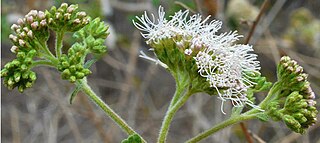
Eupatorieae is a tribe of over 2000 species of plants in the family Asteraceae. Most of the species are native to tropical, subtropical, and warm temperate areas of the Americas, but some are found elsewhere. Well-known members are Stevia rebaudiana, a number of medicinal plants (Eupatorium), and a variety of late summer to autumn blooming garden flowers, including Ageratum (flossflower), Conoclinium (mistflower), and Liatris.

Dyckia is a genus of plants in the family Bromeliaceae, subfamily Pitcairnioideae.

Fleischmannia is a genus of flowering plant in the family Asteraceae. The name honours Gottfried F. Fleischmann (1777–1850), the teacher of Carl Heinrich Schultz at University of Erlangen–Nuremberg. Members of the genus are native to South, Central, and North America, with some species found as far north as Virginia and Illinois. They are commonly known as thoroughworts.

Austroeupatorium is a genus of plants native primarily to South America, including herbaceous perennials and shrubs. The native range is focused on eastern South America and extends as far north as Panama and Trinidad and as far west as Bolivia.
Agenium is a genus of South American plants in the grass family.
Austrocritonia is a genus of flowering plants in the family Asteraceae.

Bejaranoa is a genus of South American flowering plants in the family Asteraceae.
Campovassouria is a genus of flowering plants in the family Asteraceae.
Dasycondylus is a genus of flowering plants in the family Asteraceae.
Lomatozona is a genus of Brazilian flowering plants in the tribe Eupatorieae within the family Asteraceae.
Neocabreria is a genus of Brazilian flowering plants in the tribe Eupatorieae within the family Asteraceae.

Pseudobrickellia is a genus of Brazilian plants in the tribe Eupatorieae within the family Asteraceae.

Symphyopappus is a genus of South American plants in the tribe Eupatorieae within the family Asteraceae.
Trichogoniopsis is a genus of Brazilian plants in the tribe Eupatorieae within the family Asteraceae.

Urolepis is a genus of South American plants in the tribe Eupatorieae within the family Asteraceae.
Vittetia is a genus of Brazilian plants in the tribe Eupatorieae within the family Asteraceae.

Dimerostemma is a genus of flowering plants in the family Asteraceae. It now includes all the species in the former genus Angelphytum as the two were merged in 2007.

Algar Telecom is a Brazilian telecommunications company present in the states of Goiás, Mato Grosso do Sul, Minas Gerais, Paraná, Rio de Janeiro, Rio Grande do Sul, Santa Catarina, São Paulo, and in the Federal District as well. The company is the only operator that remained private, even after the creation of Telebrás in the military regime, and it is characterized as the fifth largest company in the telecommunications segment. It serves more than one million and four hundred thousand customers - individuals, micro and small businesses, corporate customers, and carriers.









